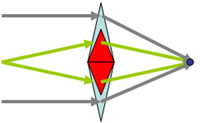Multifocal
How do multifocal lenses work?
Multifocal lenses, however, incorporate both distance- and near-powered lenses into one lens. The lower-powered zones bend light coming from distant objects to a single focal point on the retina. The higher-powered zones bend light from near objects to the same focal point on the retina. Thus, different zones of lens power work together to provide simultaneous near and distance vision.
 |
A multifocal lens can bend light |
Several types of multifocal IOL lenses are currently available for implantation in the eye. The ReZoom™ lens and the ReStor™ lens are two commonly used lenses that work by the multifocal lens principle. Each lens incorporates ring-shaped zones of differing optical power to provide a multifocal effect.
 |
 |
ReZoom Multifocal Lens |
ReStor Multifocal Lens |
What are the Pros and Cons of Multifocal lenses?
The main advantage offered by multifocal lenses is the opportunity to become less dependent on reading glasses for near activities. Activities that were once easily enjoyed without glasses, such as reading or sewing, now require that a pair of reading glasses always be available. For people frustrated by the need for reading glasses, multifocal lenses offer a good alternative.
For example, in the FDA trial of the ReSTOR multifocal lens, 84% of ReSTOR patients achieved simultaneous 20/25 distance vision, which is a single line away from perfect 20/20 vision, and near vision that allowed newsprint to be easily read. However, only 23% of patients with monofocal IOL lenses in the same study were able to achieve those levels of distance and near vision simultaneous. The clinical trials for the ReZoom multifocal IOL and Crystalens accommodating IOL also demonstrated markedly better simultaneous near and distance vision with these lenses compared to traditional monofocal IOLs.
The trade-off for simultaneous distance and near vision with multifocal lenses is a higher amount of optical aberrations produced by the lenses multifocal optics. Typically, these aberrations are perceived as glare in certain low lighting situations and halos around light sources at night. Most people with multifocal lenses find these aberrations to be mildly annoying. In fact, the brain tends to adapt to them with time. However, full adaptation may take several months. Additionally, multifocal lenses usually need to be implanted in both eyes before full adaptation can occur. Also, since the optics of these lenses split the light, the image formed on the retina is slightly less perfect than that which can be formed by an aspheric monofocal IOL. Hence, a small amount of image quality may also be sacrificed to gain the multifocal effect. The vast majority of people with multifocal implants are very happy with them and would chose to have them placed again. However, a small minority of patients do not adapt to the lenses well or are very bothered by the glare and halos that can occur with them. Your surgeon will discuss the pros and cons of these lenses with you and help you make the best choice about what kind of lens you should have implanted.

